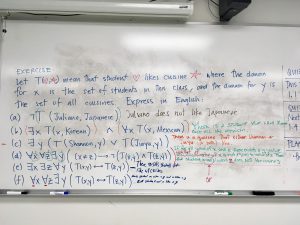Quiz #3 will be given in class this Thursday, March 2. It will cover material/homework from Section 1.7.
Author: Kate Poirier (Page 3 of 3)
Here is a photo of the board from the end of the lesson on nested quantifiers. Part of our discussion was a little rushed, so I wanted to recap here.
Recall that means that student
likes cuisine
. Recall also that the names
and
don’t matter…what matters is that the first entry is always a student and the second entry is always a cuisine. The exercise was to translate the propositions below into English sentences.
(a) translates to “Juliano does not like Japanese food.”
(b) translates to “There is a student who likes Korean food and all students like Mexican food.”
(c) translates to “There exits a cuisine that either Shannon or Jiayu (or both) like.”
(d) …let’s do this translation in a few steps:
translates to “Students x and z like cuisine y.”
translates to “It is not the case that students x and z like cuisine y,” which we can translate to “Either student x or student z does not like cuisine y.”
translates to “If x and z are different students, then either student x or student z does not like cuisine y.”
- So far none of the statements are propositions, since we don’t know the values of the variables, but we can turn the last statement into a proposition by adding the quantifiers.
translates to “For all students x and students z there exists a cuisine y such that if x and z are different students, then either student x or student z does not like cuisine y.” We can translate this into a more natural sentence in English by eliminating the variables: “For any pair of two distinct students, there is a cuisine that one of the students does not like.”
(e) …again, let’s do this translation in a few steps:
translates to “Student x likes cuisine y if and only if student z likes cuisine y.”
- Again, the above statement is not a proposition since we don’t know the values of the variables, but we can upgrade it to a proposition by adding the quantifiers.
translates to “There exists a student x such that there exists a student z such that for all cuisines y, student x likes cuisine y if and only if student z likes cuisine y.” We can translate this into a more natural sentence in English: “There exits a pair of two students who like all the same cuisines as one another and don’t like all the same cuisines as one another.“
(f) …let’s do this translation in a few steps:
is the same as in question (e)
- This time the quantifiers will change the statement to: “For all students x and for all students z there exists a cuisine y such that student x likes cuisine y if and only if student z likes cuisine y.” Again, we translate this into a more natural sentence: “For all pairs of students there is a cuisine that they either both like or both do not like.”
- Quiz #2 on Thursday, February 23 will cover material/homework from sections 1.4, 1.5, and 1.6.
- For section 1.6, the homework questions are #4, #10, #19, #20, and #35. I will change the calendar to reflect this, but the course outline will not be updated.
- For 1.6 #3 (done by you and your partner in class today) you can check the back of the text to make sure your answers are correct. If you have any questions, you can post them here on the OpenLab or ask them in my office hours on Tuesday 11am-1pm.
Prove that the following compound propositions are equivalent:
and
and
and
and
and
and
Welcome to your MAT 2440 OpenLab page! All course information will be posted here. From time to time, you will be adding posts yourself as well. Take a look around!
Your first assignment is to add yourself to our OpenLab course and to submit a post introducing yourself to the class. Your post is due by 8am on Monday, February 8.
- Sign up for an OpenLab account using your CityTech email address.
- After you’ve logged in, add yourself to our MAT 2440 class.
- From the class OpenLab site you can create a new post by clicking the symbol that looks like a + sign inside a circle at the top of the screen.
- Title your post “Introducing [your first name] [your last name].” (You may use just initials if you like, as long as there’s enough information for me to locate you on my official roster.)
- From the categories on the right-hand side of the screen, make sure to select “Introduce yourself” so that the rest of us can locate your post later.
- Tell us anything you’d like us to know about you! Some suggestions are…
- Your major
- How you got interested in math/computer science
- What you hope to do after you graduate from CityTech; short-term goals, long-term goals, whatever…
- What you hope to get out of this course (I don’t mean which grade you want!
- Other interests/hobbies you have
- Read and comment on at least one your classmates’ posts. (Note: the administrator will have to approve your comments, so don’t be surprised if they don’t appear right away.)




Recent Comments